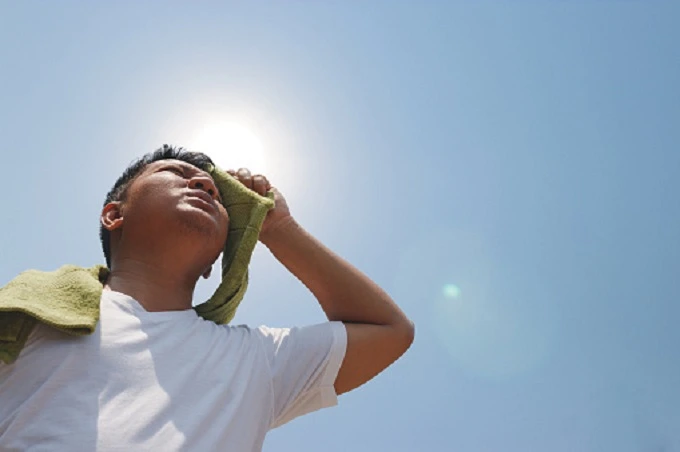Heat stroke: symptoms, causes, preventions, and what to do if it happens

When the core temperature of the body rises above 104 degrees Fahrenheit, a condition known as heat stroke can occur. This occurs due to engaging in heavy exercise for an extended period during the hot season or exposure to high temperatures.
It is essential to be aware of the symptoms of heat stroke and be prepared for what to do if you develop one. If you don’t avoid it, it can cause many health problems.
Heat stroke symptoms

The presence of physical fatigue is an early warning sign in the majority of cases of heat stroke. Other symptoms of this condition include the following:
- increased internal body temperature, which can go as high as 40 degrees;
- symptoms such as muddled thinking, slurred speech, irritability, and other changes in behavior and consciousness;
- headache;
- a feeling of stickiness, excessive sweating, and a pale complexion;
- aches and pains in the arms, legs, and stomach;
- the quickening of the breath and the pulse;
- nausea and vomiting;
- Constant desire to drink.
Who is more at risk for heat stroke?
Anyone can get heatstroke. However, infants, younger children, and older people older than 65 are at an increased risk. People who have heart disease, high blood pressure, or are taking medication for mental illness are also more likely to experience it.
what causes heat stroke

A variety of different factors can bring on this condition.
The first of these is becoming dehydrated. Our body requires a sufficient amount of water to keep our internal temperature where it should be, especially in warmer climates. Sweating, which typically accounts for 70–80 percent of heat loss, is the primary means by which the body cools itself. When a person is dehydrated, they sweat less, and their body temperature, on the other hand, rises.
It is possible to become dehydrated when engaging in strenuous physical activity during the hotter months, after episodes of vomiting and diarrhoea, when consuming large amounts of alcohol, and when taking certain medications, such as diuretics.
Also, if we remain in unventilated rooms for an extended time, we risk suffering from heat stroke. Or, we are subjected to the dynamic influence of the sun, the height of which is typically observed between the hours of 11 and 15 hours.
Attending concerts and other events can also make you feel ill if they are held in confined spaces with inadequate ventilation, mainly if many people congregate in those spaces.
How to prevent heat stroke

You need to be familiar with what to do in different kinds of uncertain conditions to avoid the unpleasant signs and effects of heat stroke.
1. Get plenty of fluids into your system by drinking water
Maintaining the fluid balance in your body, which is necessary for sweating and cooling off, can be assisted by drinking water and other non-alcoholic, cool liquids. However, you shouldn’t drink anything with ice in it if you want to avoid experiencing stomach cramps.
When engaging in physical activity during the summer, going to the beach, or spending a significant amount of time outside in the sun, it is essential to consume a lot of water.
2. Make sure that your activity is well-planned in advance
I don’t want to let go of my workout routine over the summer as I do with other forms of entertainment. Remember to make preparations for them after the peak hours of solar activity. Additionally, during the daytime hours, you should make an effort to rest more frequently and remain indoors or in the shade.
3. Maintain a comfortable temperature inside, and make sure the air gets circulated
When we have air conditioning, it is much simpler to get through the hot summer days and maintain the temperature we want. However, if it is not present, there are a few other ways to keep the room’s temperature. For instance, you could humidify the air and draw the drapes so that the sun’s rays are blocked from entering the room. You can accomplish this by using a spray bottle to evenly distribute water throughout the space every one and a half hours.
4. Choose the appropriate clothing
Pick clothes with lighter colors and more natural fibers to keep your body from getting too hot. Both linen and cotton are acceptable. It is important to pay attention to baggy styles that allow for good air circulation. When you are getting ready to leave the house, make sure that you take along hats and sunglasses with you.
5. Adopt a healthy diet and give up bad habits like smoking and drinking
On hot days, you should try to eat more vegetables and fruits that contain moisture and nutrients. However, you should avoid consuming any foods that are fried or high in fat. You really ought to stay away from sugary carbonated drinks as well.
On hot days, you should try to avoid smoking and drinking alcohol because doing so will lighten the load on your cardiovascular system.
What to do if you have a heat stroke
When dealing with a case of heat stroke, the first step is to get medical assistance as soon as possible. Or, you could inquire about it with those who are nearby. The next step is to look for a cool location. It could be a shopping center in the area or a shady spot under a tree.
Get rid of any clothing that makes you feel hotter, such as long-sleeved shirts and tight pants so that you can cool down more quickly. Of course, provided that the circumstances you currently find yourself permit it. In addition, if you cannot do so, you should consider rolling up the sleeves of your shirt and tucking the edges of your jeans into themselves as much as possible to improve your condition.
Apply ice, towels, or any other cool items you have handy to your face, forehead, neck, and underarms. This will help you feel more comfortable.
However, before you wait for the doctors to arrive, you shouldn’t go grab a bottle of water. Some people who have suffered from heat stroke have difficulty swallowing and regulating the process as a result of the altered state of consciousness that they experience.




